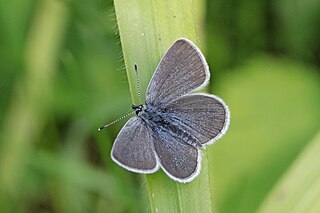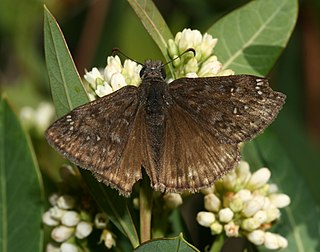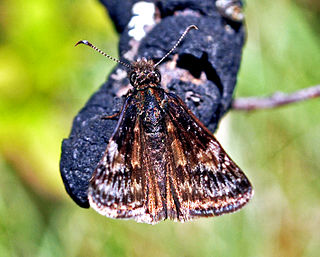
Papilio troilus, the spicebush swallowtail or green-clouded butterfly, is a common black swallowtail butterfly found in North America. It has two subspecies, Papilio troilus troilus and Papilio troilus ilioneus, the latter found mainly in the Florida peninsula. The spicebush swallowtail derives its name from its most common host plant, the spicebush, members of the genus Lindera.

The common blue butterfly or European common blue is a butterfly in the family Lycaenidae and subfamily Polyommatinae. The butterfly is found throughout the Palearctic and has been introduced to North America. Butterflies in the Polyommatinae are collectively called blues, from the coloring of the wings. Common blue males usually have wings that are blue above with a black-brown border and a white fringe. The females are usually brown above with a blue dusting and orange spots.

The dingy skipper is a species of butterfly in the family Hesperiidae.

Colias croceus, clouded yellow, is a small butterfly of the family Pieridae, the yellows and whites.

The small blue is a Palearctic butterfly in the family Lycaenidae. Despite its common name, it is not particularly blue. The male has some bluish suffusion at the base of its upper wings but is mostly dark brown like the female. The species can live in colonies of up to several hundred and in its caterpillar stage is cannibalistic.

Erynnis is a genus in the skippers butterfly family Hesperiidae, known as the duskywings. Erynnis is found in the Neotropical realm and across the Palearctic, but the highest species diversity is in the Nearctic. The genus was erected by Franz von Paula Schrank in 1801.

Polyommatus damon, the Damon blue, is a butterfly of the family Lycaenidae.

Cupido alcetas, the Provençal short-tailed blue, is a small butterfly that belongs to the family Lycaenidae.

Erynnis brizo, the sleepy duskywing or banded oak duskywing, is a species of Hesperiidae butterfly that occurs throughout North America and is commonly confused with E. juvenalis and E. lucilius. The species is listed as threatened in Connecticut and Maine.

Erynnis persius, commonly known as Persius duskywing, is a species of butterfly in the family Hesperiidae that occurs in North America. The eastern subspecies Erynnis persius persius is rarer and protected by law in some regions.

Erynnis horatius, commonly known as Horace's duskywing, is a species of butterfly in the family Hesperiidae. It is found in the United States from Massachusetts to Florida, and west to eastern South Dakota, the Gulf Coast, south-eastern Utah, Colorado, north-eastern Arizona, and New Mexico. It is listed as a species of special concern in the US state of Connecticut.

Erynnis icelus, also known as the dreamy duskywing or aspen dusky wing, is a species of butterfly in the family Hesperiidae. It is found in boreal North America.

Erynnis propertius, commonly known as Propertius duskywing, is a species of butterfly in the family Hesperiidae. It is found in along the west coast of North America from southern British Columbia south along the Pacific Slope to Baja California Norte. It is one of the most commonly seen skippers in California.

Erynnis zarucco, commonly known as the zarucco duskywing, is a species of butterfly in the family Hesperiidae. It is found (rarely) from southern Ontario to the southeastern United States.

Erynnis lucilius, the columbine duskywing, is a species of butterfly in the family Hesperiidae. It is found in North America from southern Quebec to Manitoba and south to the north-eastern United States. It is part of the skipper family because its wings create a skipping pattern.

Erynnis martialis, commonly known as the mottled duskywing, is a species of butterfly in the family Hesperiidae. It is found in most of the eastern United States and in southern Ontario, and southeastern Manitoba. It is listed as a species of special concern and believed extirpated in the US state of Connecticut.

Erynnis pacuvius, also known as Pacuvius duskywing, Dyar's duskywing or buckthorn dusky wing, is a species of skipper butterfly in the family Hesperiidae. It is found in southern British Columbia and in most of the western United States.

Erynnis afranius, also known as the afranius duskywing or bald duskywing, is a species of butterfly of the family Hesperiidae. It is found from northern Mexico through the central United States to southern Canada in the provinces of Alberta, Saskatchewan and Manitoba.

Erynnis tristis, commonly known as the mournful duskywing, is a species of spread-wing skipper in the butterfly family Hesperiidae. It is found in Central America, North America, and South America. It is mottled brown with a white fringe on the hind wings. It appears similar to the funereal duskywing, but the mournful duskywing is more likely to appear in urban areas. The larva feeds on young oaks while adults nectar from a variety of wild and garden flowers.




















